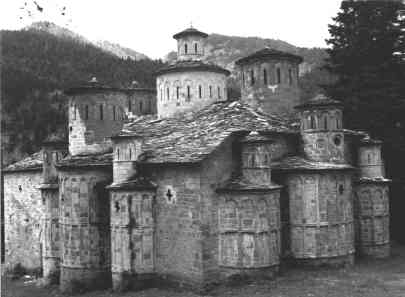 It is located between Doliana and Krania in the heart of the southern Pindos. It is about 50 kilometers away from Kalampaka being connected to the main road, a 500 kilometer long dirt road. It is built on a ridge of about 1.150 meters. However, it isn’t visible from the main road as a forest of huge firs covers it.
It is located between Doliana and Krania in the heart of the southern Pindos. It is about 50 kilometers away from Kalampaka being connected to the main road, a 500 kilometer long dirt road. It is built on a ridge of about 1.150 meters. However, it isn’t visible from the main road as a forest of huge firs covers it.
It must have been built in the 17th century but we can’t be sure for the exact chronicle as the is no further information.
It was completely burned by the “Christians” German people in autumn of 1943( perhaps in retaliation to the execution of 80 german captives there). The monastery of the holy cross had monks before its burn. Today is abandoned.
It celebrates on the 14th of September and every year our metropolitan participates in the this celebration. It also celebrates on the 15th of August.
It should be mentioned that some restoration and maintenance work took place in the past from the donations of the people and of course under the supervision of the ministry of culture. But there are some more things that need to be done. It looks very impressive from the outside.
It is built of stones and covered with the paving stones and it is a monastery of royal rhythm with domes. The many domes make it look unique.
Certainly here there is the Dancing DOMES. The main dome( recently has been restored) is double(with two floors) something rare I think, I won’t reveal how many there are so that counting them can be interesting. In any case, the number is two-digit.
It is mentioned in a magazine that there are 5 domes. But it is not true. A newspaper in Athens mentioned that the monastery is situated between Epirus and Albania. What can somebody say!!! On the side of the main entrance southerly, there are carved stones with figures of the Saint George, saint Dimitrios, saint Konstantinos-Helen, angels etc.
The well done one piece stone, which surrounds the north wooden door with the key, is very impressive too. On the contrary, the west new door is surrounded by stones cut into pieces. Some differences between technicians-craftsmen? Maybe. Both entrances are so low that people have to stoop to get in. Pious pilgrimage? Maybe.
The internal place is a little bit dark and the little light comes in from the small windows of the domes. There is no electricity current. The roof is supported by columns made of cut, round stones put one on top of the other. The shaped bows and the arches in the connections on the top of the columns as well as the domes make it more impressive.
They have used a lot of tufa stone so as not to be too heavy. Between the roof and the ceiling there are huge gaps crypts. The small and the large niches are very impressive too. In various places on the walls there are some built ceramic vessels with the spouts towards the internal temple. The intention is the good quality of acoustics. The internal place has not been painted. I heard in the past some experts to say they should be coated. However, will be good or bad?
The temple is carved and new as the old one has been burned as well as the icons. Behind the high altar there are some stone seats(chairs) like those in the church of Virgin Mother in Kalampaka (but very few). On the southern side there was a hidden staircase that led to the crypts upstairs. Recently they have created the staircase and the dome. During the years of slavering there was a secret school.
I don’t know if I was able to inform you in a right way. I did my best anyway, even though I’m not an expert. All those I mentioned are my experiences and things I have lived with as there is no bibliography at all, unfortunately. I apologize for my mistakes.
Putting an end, I’d like to make a wish. Since we can’t create new masterpieces let’s maintain all these we have inherited from our ancestors in order to leave something to our children.
I suggest you all to visit the monastery. I can assure you it is not a waste of time!!
Ioannis Psarris

